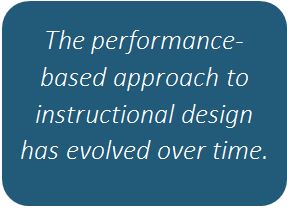Competency Based Learning Approach
Excerpt from WIDS History White Paper
In competency-based learning, educators tell learners what the competency expectations are up front, before instruction begins. This approach is also sometimes called performance-based learning. Curriculum defines those expectations in terms of learning outcomes and informs students of them upfront.
Oz is Not Alone
In the past, many educators thought of the learning process as more subjective: students sit at the fount of knowledge for the pure joy of learning, and the value of the learning is measured in esoteric terms. Douglas Reeves, founder of The Leadership and Learning Center, calls this the "Oz effect" where "in matters of literature, philosophy, or social science, proficiency is no longer clear, and the definition of acceptable student performance must rest with the judgment of experts." In other words, "the great and powerful Oz retains power as long as there is no Dorothy and Toto to look behind the curtain."
Michael Wesch, cultural anthropologist at Kansas State University, tosses the traditional teacher-centered approach out the window. “Oz” educators now have to share expertise with a huge cast of easily accessible information sources. Traditional classrooms "built to re-enforce the top-down authoritative knowledge of the teacher are now enveloped by a cloud of ubiquitous digital information where knowledge is made, not found." Behind this massive shift away from the teacher as the sole source of knowledge, "there is still the question of 'what' is to be learned" (Wesch, 2009).
Toward Higher Levels of Cognition
Initially, the term "outcome" emerged from Tyler, Bloom, and Mager and their early work in developing behavioral objectives. Some valid criticisms of these early approaches include an over-emphasis on writing learning outcomes. In many cases, outcomes were written without determining how they impact teaching strategies, learning activities, and assessment. Sometimes learning outcomes were written at low cognitive levels, according to Bloom's taxonomy (Bloom, 1956). An individual course, for example, might have 30 or more low-level outcomes that result in knowledge-based testing and an emphasis on "checking off" competencies rather than high level cognitive performance.
Today, competency-based instruction emphasizes outcomes that reflect comprehensive performances, using verbs from higher levels of Bloom's taxonomy. Outcomes written at these levels require high level cognitive performance rather than simple recall. PBL also promotes authentic assessment of high level outcomes, both at the course and program level. The rationale: if educators must quantify student learning with grades, then those grades should be based on evidence of student performance related to defined outcomes.
From Grades to Meaningful Assessment
Grades are only one measure of competence; and in many cases, they have lost their meaning. With a competency-based approach, learning outcomes and assessment tasks are clearly defined and tightly linked. Performance results can be specified as a set of proven skills or knowledge. Results can be aggregated for the institution and provide valid assessment data. This approach can give educators and administrators a more complete picture than grades alone. Additional student success measures may include:
- numbers of students successfully completing a course or program
- numbers of students completing a skills set, describe in a competency report card
- numbers of students using their skills after graduation
Well-written outcomes and standards can enhance the quality of critical and creative thinking, discussion, and intellectual pursuits in the classroom. Building authentic learning environments and assessment can leverage these pursuits, and in the case of performance-based learning, promote and diagnose learning.
Access our 2008 white paper - WIDS History to learn more about WIDS.
8464